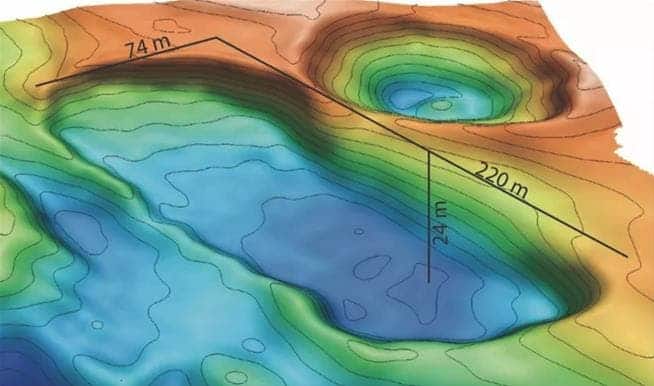The Arctic offshore is being riddled with sinkholes, according to new research. While the main cause is believed to be natural processes that are related to the last Ice Age, it remains unclear whether man-made climate change is contributing to the formation of these sinkholes or not.

Permafrost is melting all throughout the traditionally-frigid areas of the world. The Arctic is no exception. Landscapes here are littered with sinkholes, areas of collapsed ground that cause deep holes in the surface. New research points to the same process happening under the waters, as well. The thawing of one large area of permafrost at a depth of 500 on the continental slope of Canada’s Beaufort Sea is causing “extraordinarily rapid morphologic changes”, the authors explain.
The speed of these collapses is particularly surprising as the process is not linked to methane gas explosions or human-driven climate change, as they are in other areas of the world.
Bottom of the sea, bottoming out
“We know that big changes are happening across the Arctic landscape, but this is the first time we’ve been able to deploy technology to see that changes are happening offshore too,” said Charlie Paull, a geologist at MBARI who led the study.
“While the underwater sinkholes we have discovered are the result of longer-term, glacial-interglacial climate cycles, we know the Arctic is warming faster than any region on Earth. As climate change continues to reshape the Arctic, it’s critical that we also understand changes in the submerged permafrost offshore.”
The team mapped a 10 sq mile (25.9 sq kilometers) area of seafloor between 2010 and 2019, reporting on the emergence of no less than 41 sinkholes over the study’s period. The average depth of these sinkholes is 22 ft (6.7 m). The largest one, however, measured 738 by 321 ft (225 by 98 m) with a depth of 95 ft (29 m), making it large enough to hold “a city block made up of six-story buildings,” according to one CNN estimate.
These sinkholes seem to go hand-in-hand with the emergence of ice-filled hills in other areas of the seafloor.
Although data on seafloor temperatures in the area are limited, what we have doesn’t seem to indicate a meaningful warming trend at this level. In essence, the team believes the sinkholes and rising hills are caused by ground collapsing into empty spaces left by thawing permafrost layers, which seem to be melting due to heat carried in (slowly) through groundwater networks. These, in turn “derive from much older, slower climatic shifts related to Earth’s emergence from the last ice age, and appear to have been happening along the edge of the permafrost for thousands of years,” Paull told Newsweek.
“This research was made possible through international collaboration over the past decade that has provided access to modern marine research platforms such as MBARI’s autonomous robotic technology and icebreakers operated by the Canadian Coast Guard and the Korean Polar Research Institute,” said lead co-author Scott Dallimore from the Geological Survey of Canada and Natural Resources Canada.
“The Government of Canada and the Inuvialuit people who live on the coast of the Beaufort Sea highly value this research as the complex processes described have implications for the assessment of geohazards, creation of unique marine habitat, and our understanding of biogeochemical processes.”
Limited data for seafloor temperature don’t show a warming trend. Rather, “the evidence suggests that the submarine features we observed forming are essentially sinkholes and retreating scarps, collapsing into void space left behind by the thawing of ice-rich permafrost,” due to heat carried in slowly moving groundwater systems, Paull tells Newsweek. Such changes “derive from much older, slower climatic shifts related to Earth’s emergence from the last ice age, and appear to have been happening along the edge of the permafrost for thousands of years,” Paull adds.
That being said, it remains unclear if and how man-made climate change is impacting this process. Groundwater infiltration from permafrost melting on Arctic soil seems to be the main avenue through which heat is being introduced into the underwater environment; underwater areas where groundwater infiltration is lowest are remaining relatively frozen, according to the team. We do know that melting on the surface is largely connected to man-made climate change, so there is at least a weak connection between the two processes, but there are simply too many unknowns at present to draw any reliable conclusions.
The researchers believe that similar thawing and collapses are occurring in underwater permafrost systems in other areas of the world as well, but the data we have so far is insufficient to estimate how widespread this is.
The team will be continuing their research during the Arctic summer using ship-based sonar and autonomous underwater vehicles (AUVs) in a bid to fill in our understanding of these elements.
The paper “Rapid seafloor changes associated with the degradation of Arctic submarine permafrost” has been published in the journal Proceedings of the National Academy of Sciences.


